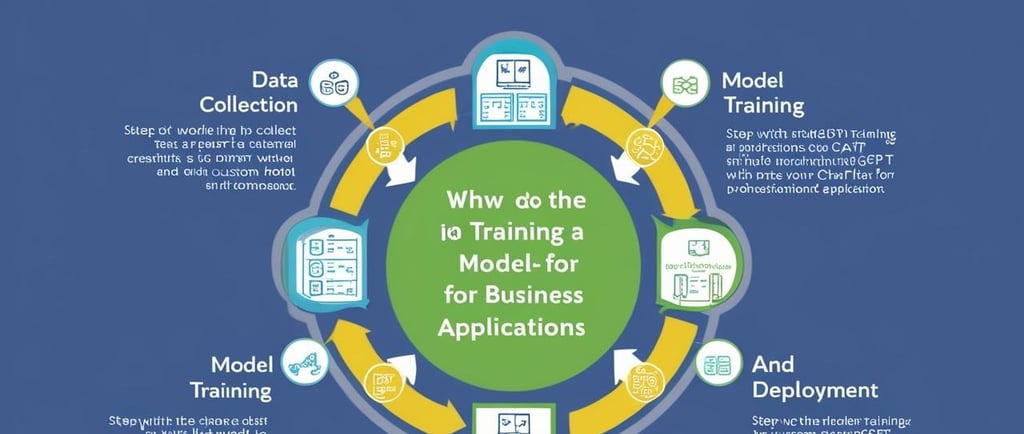How to Train a Custom ChatGPT Model for Your Business
"Learn how to train a custom ChatGPT model for your business with this comprehensive guide. Discover the steps, tools, and strategies to tailor AI for specific needs, enhancing customer interactions and streamlining operations."
TUTORIAL AND GUIDE


Artificial intelligence is reshaping the way businesses interact with customers, streamline operations, and deliver value. Among AI tools, custom-trained ChatGPT models stand out as powerful solutions for personalized customer support, content creation, and workflow automation. But how can a business create a tailored ChatGPT model that perfectly aligns with its unique needs?
In this guide, we’ll walk you through the steps to train a custom ChatGPT model for your business, breaking down the process into actionable steps. Whether you're aiming to enhance customer engagement or automate repetitive tasks, this guide will set you on the right track.
Why Train a Custom ChatGPT Model?
A general ChatGPT model is highly capable but may lack specific knowledge or tone required for your business. Customizing a ChatGPT model allows you to:
1. Reflect Your Brand Voice: Ensure interactions align with your business’s tone and values.
2. Enhance Specificity: Train the model on your industry, product, or service knowledge.
3. Improve Efficiency: Streamline workflows with tailored prompts and responses.
4. Increase Customer Satisfaction: Deliver personalized experiences that feel authentic and relevant.
Step 1: Define Your Goals and Use Cases
Before diving into the technical details, identify your objectives:
- What problems are you solving? Do you need a chatbot for customer support, a tool for drafting emails, or a system to assist with data analysis?
- Who will use it? Is it for customers, employees, or partners?
- What outcomes do you expect? Clear goals will guide the training process and help measure success.
Step 2: Collect and Prepare Your Data
The quality of your custom ChatGPT model depends heavily on the data you provide. Here's how to get started:
1. Gather Relevant Data:
- Customer service transcripts.
- Product documentation and FAQs.
- Marketing materials, blog posts, or training manuals.
2. Clean Your Data:
- Remove sensitive information.
- Ensure consistency in formatting and tone.
- Organize data into clear categories (e.g., customer queries, technical explanations).
3. Augment with Synthetic Data: If needed, create example conversations or scenarios to fill gaps in your dataset.
Step 3: Choose the Right Platform
Training a custom ChatGPT model doesn’t require building everything from scratch. Platforms like OpenAI’s fine-tuning API make the process straightforward.
Popular Tools and Platforms:
- OpenAI: Offers fine-tuning for GPT models with your custom dataset.
- Hugging Face: A versatile platform for AI model training and deployment.
- Google Cloud AI or AWS AI Services: Ideal for integrating AI into existing cloud infrastructures.
Step 4: Fine-Tune the Model
Fine-tuning adjusts a pre-trained ChatGPT model to specialize in your data. Here’s how:
1. Format the Dataset:
- Use a JSONL file structure, where each entry includes prompts and responses.
2. Upload and Train:
- Use OpenAI’s API to upload your dataset.
- Adjust parameters like learning rate and epochs for optimal performance.
3. Test and Refine:
- Evaluate the model’s performance on unseen examples.
- Iteratively improve the dataset and retrain if needed.
Step 5: Integrate and Deploy
Once your custom model is ready, integrate it into your business processes:
- Customer Support: Deploy it on your website or app to answer FAQs and assist customers.
- Internal Tools: Use it for drafting reports, summarizing meetings, or generating insights.
- Marketing: Generate personalized email campaigns or social media content.
Make sure to monitor its performance and gather feedback from users for ongoing improvements.
Tips for Success
1. Start Small: Begin with a focused use case and expand as you gain confidence.
2. Ensure Compliance: Follow data privacy regulations like GDPR or CCPA when using customer data.
3. Prioritize Accuracy: Regularly update the model with new data to maintain relevance.
4. Train Your Team: Educate employees on how to effectively use and monitor the AI system.
Real-World Applications
Businesses across industries are leveraging custom ChatGPT models:
- E-commerce: AI chatbots guide shoppers, recommend products, and manage returns.
- Healthcare: Virtual assistants provide symptom checks, appointment scheduling, and health education.
- Education: AI tutors assist with personalized learning plans and instant feedback.
Conclusion
Training a custom ChatGPT model is an investment in efficiency, personalization, and innovation. By tailoring AI to your business’s specific needs, you’ll not only enhance user experiences but also gain a competitive edge.
With clear goals, high-quality data, and the right tools, your business can harness the power of AI to drive growth and improve operations. Start today, and see how a custom ChatGPT model can transform your business processes.
Read more relevant articles: "How to Set Up AI-Powered SEO for Your Website".